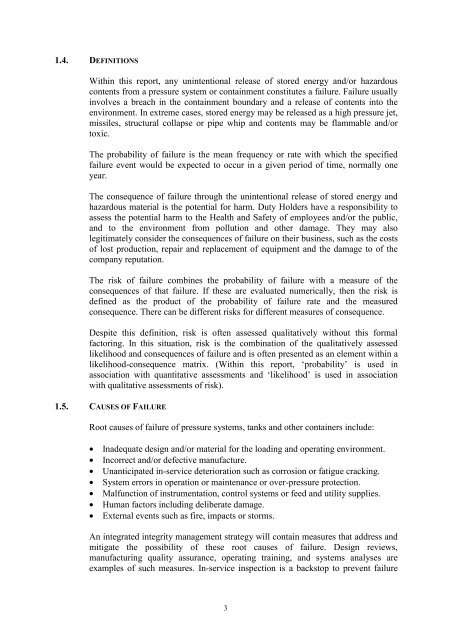Best Practice for Risk Based Inspection
risk based inspection
risk based inspection
Create successful ePaper yourself
Turn your PDF publications into a flip-book with our unique Google optimized e-Paper software.
1.4. DEFINITIONS<br />
Within this report, any unintentional release of stored energy and/or hazardous<br />
contents from a pressure system or containment constitutes a failure. Failure usually<br />
involves a breach in the containment boundary and a release of contents into the<br />
environment. In extreme cases, stored energy may be released as a high pressure jet,<br />
missiles, structural collapse or pipe whip and contents may be flammable and/or<br />
toxic.<br />
The probability of failure is the mean frequency or rate with which the specified<br />
failure event would be expected to occur in a given period of time, normally one<br />
year.<br />
The consequence of failure through the unintentional release of stored energy and<br />
hazardous material is the potential <strong>for</strong> harm. Duty Holders have a responsibility to<br />
assess the potential harm to the Health and Safety of employees and/or the public,<br />
and to the environment from pollution and other damage. They may also<br />
legitimately consider the consequences of failure on their business, such as the costs<br />
of lost production, repair and replacement of equipment and the damage to of the<br />
company reputation.<br />
The risk of failure combines the probability of failure with a measure of the<br />
consequences of that failure. If these are evaluated numerically, then the risk is<br />
defined as the product of the probability of failure rate and the measured<br />
consequence. There can be different risks <strong>for</strong> different measures of consequence.<br />
Despite this definition, risk is often assessed qualitatively without this <strong>for</strong>mal<br />
factoring. In this situation, risk is the combination of the qualitatively assessed<br />
likelihood and consequences of failure and is often presented as an element within a<br />
likelihood-consequence matrix. (Within this report, ‘probability’ is used in<br />
association with quantitative assessments and ‘likelihood’ is used in association<br />
with qualitative assessments of risk).<br />
1.5. CAUSES OF FAILURE<br />
Root causes of failure of pressure systems, tanks and other containers include:<br />
• Inadequate design and/or material <strong>for</strong> the loading and operating environment.<br />
• Incorrect and/or defective manufacture.<br />
• Unanticipated in-service deterioration such as corrosion or fatigue cracking.<br />
• System errors in operation or maintenance or over-pressure protection.<br />
• Malfunction of instrumentation, control systems or feed and utility supplies.<br />
• Human factors including deliberate damage.<br />
• External events such as fire, impacts or storms.<br />
An integrated integrity management strategy will contain measures that address and<br />
mitigate the possibility of these root causes of failure. Design reviews,<br />
manufacturing quality assurance, operating training, and systems analyses are<br />
examples of such measures. In-service inspection is a backstop to prevent failure<br />
3



